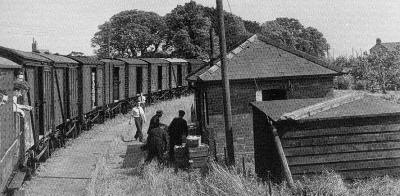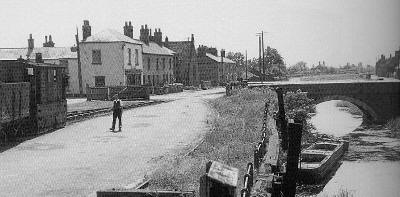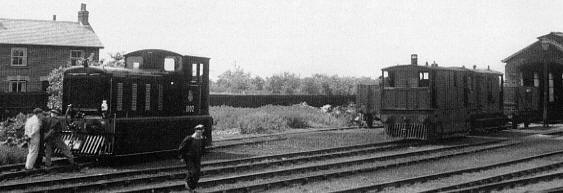The Wisbech and Upwell Tramway: History

Wisbech was a major market town that was also a port until the 13th Century when the estuary finally silted up. Fortunes start to suffer, but recovered when a series of canals and drainage channels were cut in the surrounding countryside. This resulted in the reclaiming of the surrounding fens for agricultural use, and Wisbech once again became a prosperous port despite being 12 miles from the sea. This agricultural prosperity attracted railways at an early stage. The Eastern Counties Railway opened a short branch from March on 3rd March 1847. Shortly afterwards in 1st February 1848, the East Anglian Railway built a branch from Watlington (now Magdalen Road). These later joined to form the Great Eastern Railway (GER) and the two lines were joined to permit through running. A third line was built by the Peterborough, Wisbech & Sutton Bridge Railway (later the Midland & Great Northern Joint Railway) which opened a station on the other side of the River Nene on 1st August 1966.
All of these lines carried the very lucrative traffic of fruit and vegetables to the markets of the Midlands and London. The GER's services were particularly profitable, and a line was proposed to Outwell and Upwell to operate as a feeder. In 1873, W.L. Ollard gained Parliamentary powers to build just such a line, but had problems raising sufficient funds. The powers lapsed in 1884. The GER was still keen to build the line, and a new proposal was included in its General Powers bill of 1882. The GER decided to build the line as a tramway experiment with the Board of Trade's support, in an attempt to bring the railways to places that would not be economic with a normal line. As such, it had much in common with the Light Railways that would follow, and in fact the 1896 Light Railway Act was partly due to the Wisbech & Upwell's success.
Land purchases started in February 1882, and generally went without a hitch. Most of the landowners were happy to sell at a reasonable rate because they knew the tramway would increase the value of their remaining land. One owner proved difficult, asking for £590 for two rods and fifteen perches of land. The court settlement awarded the much smaller sum of £250 and this probably stopped any further difficulties. Tenders were accepted in 1882, and construction proceeded rapidly across the flat countryside.

The line opened to Outwell Basin on 20th August 1883 to great fanfare. The fares charged were considered to be very low for both goods and passengers. Initial passenger services allowed picking up and dropping off anywhere along the line. Road surveyors also welcomed the tramway because it would allow the delivery of granite chips exactly to where they were required.
The final stretch of 1 mile 62 chains from Outwell Basin to Upwell opened a year later on 8th September 1884. Initial passenger services were six trams a day in each direction, with the full one way journey taking one hour. The local newspaper was quick to ask for the line to be extended to Welney, Downham, and other districts around Wisbech; but the GER declined until it gained operational experience and could prove that the tramway was profitable. By October 1884, traffic had grown to 3000 passengers per week with peaks of 2000 in a day for fetes and other special events.
The tram competed with a canal that ran between Wisbech and Upwell. The canal was in a poor financial condition even before the tramway opened, but the tram finished it off. By 1914 it was only collecting £56 in tolls and it was abandoned soon afterwards. For a time though, the tramway benefited the canals. Large quantities of coal would be shipped to Outwell Village during the late 19th Century, where it was off-loaded via chutes into barges for transport deeper into the fens.
Although the Wisbech & Upwell enjoyed a certain degree of prosperity, the tramway was not profitable in its own right. The real value to the GER was in its contribution of freight and passenger traffic to the main line. This marginal nature of its profitability, led to the GER deciding not to construct any further tramways in the Fens. The GER attempted to build an extension at Wisbech down the streets to the market place. This was abandoned, which in turn caused much ill feeling in the Wisbech area towards the GER. It should be noted that most of the tramway's traffic was shipped directly to the main line for conveyance further afield, so it is unlikely that Wisbech Market would have benefited from an extension.
Despite popularity with most of the residents in the area, there were some teething problems. These generally involved shunting activities near people's houses, and road chaos due to unloading at the roadside. In order to ease the problems of shunting and unloading, the GER attempted to avoid shunting when schools closed and children were on the streets. Also shunting across the highway at Outwell was only allowed if a guard or inspector was present. Passenger pick-ups and drop-offs were limited to specified stops from 1904. To compensate, a number of request stops were added along with an increase in the speed restriction from 8mph to 12mph.
The Wisbech & Upwell Tramway entered the ownership of the LNER in 1923 with the rest of the GER network. By this time, the through journey time had been reduced from 1 hour to only 39 minutes, but was too slow compete with the motor omnibuses that had started to appear. Passenger services were withdrawn on 31st December 1927. Despite the fall in passenger traffic, freight traffic continued to flourish. By 1949, eight trips were scheduled to leave Upwell on weekdays, and three on Saturdays during the fruit season.

In 1952, two Drewry Shunters (BR Class 04) were introduced to replace the aging steam trams, and in the process gave the Wisbech & Upwell the distinction of being Britain's first all-diesel line!
Lorries started to eat into the freight traffic during the 1950s, resulting in only one service each way per day in the 1960s. The traffic was still principally "coal in, fruit and potatoes out", though! Beeching's "Axe" listed the Wisbech & Upwell amongst the lines to be cut, but it won a reprieve whilst traffic remained profitable. Various economy measures were enacted, including the closure of Boyce's Bridge and Outwell Village stations.
Official closure finally took effect on 23rd May 1966, with the last journeys being made on 20th May 1966. The last train left Upwell at 3:30pm hauled by Drewry Shunter D2201 driven by Driver Albert Smith, and included three open wagons and a goods brake van.
Next Page: Route of the Wisbech and Upwell Railway.
| Introduction | History | Route | Rolling Stock | Toby & Mavis | Further Reading |